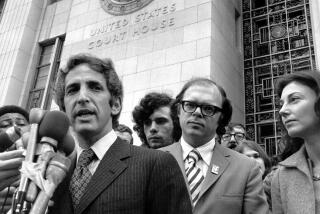Mormons Tell of Dealings With Suspect
- Share via
The Mormon Church conceded Friday that it received nearly 400 historical documents--350 more than previously acknowledged--during the last three years from a rare-documents dealer charged with murdering two people with bombs last year in a scheme to cover up the forgery of some of the papers.
A church spokesman in Salt Lake City said that about 300 court documents donated to the church in 1983 by documents dealer Mark W. Hofmann were discovered in a box by members of the church historical staff while they were assembling materials for law enforcement officials conducting the criminal investigation.
“In the course of examining these court records, historical department personnel became convinced that they were originals of public documents which would normally be retained at the site of the court and therefore should be turned over to the responsible public official,” a statement issued by the church public communications department said.
Faces 34 Counts
Hofmann, 31, faces 34 counts in Salt Lake City stemming from the Oct. 15 bombing deaths of financial consultant Steven F. Christensen and Kathleen W. Sheets, wife of Christensen’s former business partner, J. Gary Sheets. A preliminary hearing for Hofmann is scheduled to begin Monday.
In addition to bomb and homicide charges, Hofmann is charged with 23 counts of communications fraud and theft by deception. Many of those charges involve historical documents that passed into the possession of the 5.9-million-member Church of Jesus Christ of Latter-day Saints, as the Mormons are officially called. Church leaders have not been accused of any wrongdoing in the case.
Hofmann was in regular contact with high church officials interested in his research into letters, court records and other documents that detailed the 19th-Century origins of the Mormon Church.
Making Things Public
Church communications director Richard P. Lindsay said in the statement released Friday that the church was making public the extent of church dealings with Hofmann “to complete the public record and to correct erroneous speculation in the media about the acquisitions.”
The collection of 300 papers, dated between 1831 and 1865, was turned over to the clerk of Hancock County, Ill., a site of early Mormon activity. Another 45 similar court records were offered to appropriate public officials in several states, according to the church statement.
Jerry Cahill, a church spokesman, said the newly acknowledged collection of court papers includes “summonses, complaints, subpoenas, indentures and the like. . . . They appear to be of little or no significance to the history of the church.”
Known by Officials
An additional 48 documents were acquired from Hofmann and described in the church statement as “known to and mentioned by church officials” during a press conference held on Oct. 23, 1985, in Salt Lake City, Lindsay said. The church paid Hofmann a total of $57,100 in cash for seven of these historical documents--far less, Lindsay said, than “the much higher totals that have appeared in media speculation.”
The other 41 items church officials said they knew about in October were acquired from Hofmann “by donation or trade,” Lindsay added.
One previously unpublicized document on the list is a letter dated June 23, 1844, from church founder Joseph Smith to “Maria and Sarah,” sisters who were wives of the church prophet. (The Mormon practice of polygamy was officially dropped before the turn of the century.)
Some Considered Phony
Salt Lake County prosecutor Robert Stott said in a telephone interview that only about “seven or eight” of the documents listed as being obtained by the church from Hofmann are among those that prosecutors consider phony.
George Throckmorton, a documents expert with the Utah attorney general’s office, determined that 11 documents Hofmann sold to the church and other collectors were forged, according to affidavits filed in the Salt Lake City court in early February. Among the papers is the so-called “White Salamander Letter,” dated 1830, which purportedly was written by Martin Harris, an early convert to Mormonism.
More to Read
Sign up for Essential California
The most important California stories and recommendations in your inbox every morning.
You may occasionally receive promotional content from the Los Angeles Times.













